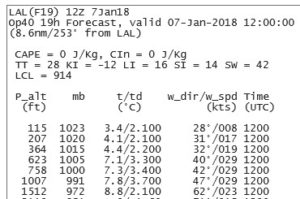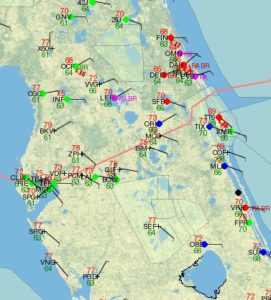There are 4 things that can stop us!
High wind
Wind is a balloons biggest enemy. Wind of more than about 10mph will make the balloon almost uncontrollable. We do not like to take passengers if the winds are more than 6 MPH.
To put a balloon up you must first fill it with air. This is done by laying the balloon on the ground and starting a large fan. You must hold the balloon still long enough to fill it with air before you turn on the burner to stand up the balloon. If you have any wind the balloon will begin to catch the wind like a giant sail and begin to drag itself across the field. A balloon can generate as much as 6,000lbs of pulling force in as little as a 12 mph wind. At this time we don't even want to talk about landing in windy conditions.
Poor Visibility
A Hot Aire Balloon is a VFR type of aircraft. This means Visual Flight Rules. These are rules written by the Federal Aviation Administration. Not only is it illegal to operate a balloon in poor visibility but imagine driving your car with your eyes closed. You're bound to hit something and it wont be pretty. To land a balloon the pilot must slow the decent of the balloon to get it to level off right at the ground level. Hard to do when you can not see the ground. We also need to have room under the clouds to fly. If the clouds are only 1,000 feet off the ground we do not have the legal distance requirements to fly. Keep in mind, there is a delay between when the pilot turns on the burnere and the balloon begins to respond. Very much having a deer run out in front of your car on the highway. By the time you see the deer its too late. Remember also that in poor visibility other aircraft can not see us either. If there is even a chance of visibilitie issues we will choose not to fly. This is (in our opinion) the most dangerous condition.
Rain
Generally when you have rain you have weather conditions that can change dramatically. Here in Florida rain is either driven by an advancing cold front or by the convective heating of the surface of the earth by our intense sunshine. In either case the rain on a balloon will add dramatic weight to the skin of the balloon forcing the pilot to add extra amounts of heat to keep the balloon aloft. It is possible for this weight to become so heavy that it literally forces the balloon into the ground. If the pilot can successfully land the balloon the damage to the fabric of the balloon will completely ruin the aircraft. WE DO NOT LIKE RAIN.
Wind Shear
There are days when it seems perfectly flyable on the ground. BUT.. In some cases the wind just above the tree tops is scooting along real good. This is what we call a "Wind Shear". There are several problems with high winds aloft. First is that your ground team can not keep up. The recovery team must travel about 2.5 times faster on the ground that you are flying in the sky in order to keep up. The balloon is going cross country and the ground team is on roads that may not go parallel to the balloons flight. On the ground they must deal with turns, stop lights, Stop Signs and TRAFFIC. If you
are flying along at 25 miles per hour they must be doing 62.5 constantly to keep up. Another problem and more severe is what the shear does to the balloon. Lets stop for a second and explain a shear. This is a point in the sky where two different layers of wind have A). a significant speed difference or B), a considerable difference in direction. When a balloon hits a wind shear it can collapse the side of the balloon causing the pilot to burn thru the skin of the balloon or the balloon can literally skip off the shear like a rock on water.
Think of it like this.
Here is a great analogy: Imagine we have placed a hula hoop about 250 feet out in a lake. You have a rock and you have to skip the rock off the water and make it stop inside the Hula Hoop. Sounds nearly impossible, Now, You get one chance at it and your betting your life on it. We won’t do that. Flying a balloon when there is a significant wind shear at low levels to the ground is simply not safe.
.
As we like to say. We have 100 reasons WE WANT TO TAKE YOU FLYING. We only have one reason we will not. SAFETY.
"I hate to dissapoint someone but I refuse to hurt anyone"
Jeff A Thompson
Thompson Aire
Weather Conditions
407-421-9322 or Contact US
Hot air balloons need light and stable winds for safe flight operations. These conditions occur most often at sunrise. As the sun rises it will heat the earth and cause the atmosphere to boil like a pot of water. That is also why we limit our flights to about an hour of flight. After an hour the atmosphere begins to boil throwing us around like a toy. See About the Aircraft for more information on how we fly a balloon.
We look at weather VERY carefully and we look at the future forecasts several times each day.
In fact we look at 9 different forecasting locations all over the central Florida areal We actual get the forecasts from several meteorologists to determine what will happen here. But in many cases we do not know much in advance of the flight. Just to put this all in perspective for you. A LONG RANGE forecast for balloons is 24 HOURS. That is right 24 hours! Things can change very quickly and we need such precise weather conditions that any forecast more than 24 hours in advance is too much of a guess. So please do not call and ask us what some flight date, two weeks out, looks like. Heck we do not know what tomorrow afternoon will bring.
You can also keep an eye on our calendar! If we know in advance that the weather will not let us fly we post notices on the TA Flight Calendar. If you see a "Weather Alert" or a "NO FLY" you can click on the link and a pop up will open and tell you exactly what we are seeing and thinking. REAL HANDY.
We do our very best to forecast weather. There are many factors that go into our decision. We are more than happy to explain to you anything you want to know about the weather. We have been watching weather for more than 40 years and when we fly we LIVE IT! As we like to say. If you were a meteorologist you may not know as much as we do about weather and even if you WERE a Meteorologist you still would not know what you can and can not fly a balloon in. PLEASE LET US MAKE THE WEATHER DECISIONS!
Please remember if you are scheduled for a flight you must call us the night before your flight to check if the weather will be good for your flight. If you do not check in you may end up at the Meeting Spot all by yourself in the morning if the weather is not good.
Weather Stations and observations around the area.
Below are some of the stations that we monitor for current conditions around the area.
Here are the stations that are closest to our flying area.
Orlando Bartow Kissimmee Winter Haven/Gilbert Lakeland Zephyrhills
Here are more regional stations that we will look at as well.
Tampa ORL Executive Deland Ocala Sanford The Villages
A TAF is a forecast written by the meteorologist at that location.
TAF (Terminal Aerodrome Forecast)
Here are some of the TAF's we look at for forecasting in our area.
Orlando TAF Kissimmee TAF Lakeland TAF Leesburg TAF Sanford TAF
RUC or RAP Soundings are forecast of the atmosphere up to 45,000 feet. ON these links you must tell the page how many hours of soundings you want to load (up to 24 hrs.) There is a box on the page that says "Load Soundings" click on that box and type in the number of hours you want to have loaded. Remember that the Time Stamp is in Universal time or Zulu/UTC.
Kissimmee Sounding Orlando Sounding Lakeland Sounding Winter Haven Sounding.
Once you have loaded the number of hours you want to see you need to click on the hour that you are interested in and then click "Get Text" This will give you a readable guide for that time period.
Another source for winds aloft forecasting is the Ryan Carlton Winds. Ryan Carlton has created an application that does the work for you. It does not provide quite as much information but it is an easy way to see the winds aloft forecast provided in an easy to use format. Here are links to the same area stations as above.
Kissimmee RC Orlando RC Lakeland RC Winter Haven RC
Then there is always the Thompson Compound weather station. This is our own station located about a mile and a half west of Disney's Animal Kingdom. This station is LIVE with more than 30 different graphics.
Thompson Compound Weather Station.
Here in Florida RADAR is also a HUGE part of our weather checks. Here are a couple of radar sites we use.
Tampa Melbourne Regional Radar
We also use a national map on occasion to see what is headed our way.
National interactive weather map. Surface Analysis chart.
Last but not least, the "Hourly Forecast"
This forecast is the only one we use to look out in advance more than 14 to 24 hours. It is fairly good for winds and for Temp/Dewpoint spreads. We look at these forecasts to get a general feel for wind speeds and for the potential of poor visibility and rain.
Kissimmee Hourly Orlando Hourly Winter Garden Hourly Winter Haven Hourly Lakeland Hourly.
So there you have it. You are now armed with the same links we use to determine what the weather will be doing. I know it seems rather complex when you start to look at all of the information we consider each time we make a GO NO/GO flight decision but it is a very serious decision that lives depend on.
SPECIAL NOTE ABOUT WEATHER.
The stations and links above are chosen because of the consistency of the data they record and forecast. There are many other weather stations in this area but they may be automated or the equipment is not maintained. Many times we will have wind all across the area and yet some of the stations have no reports of wind at all. There are also times that our 40 years of being involved with ballooning and watching the weather will give us some intuition on things the computers just do not yet comprehend. In many cases our guess is better than their facts. Weather is a very complex thing and there are so many variables that sometimes it may be horrible here and as little as 15 miles to the east it is fine.

